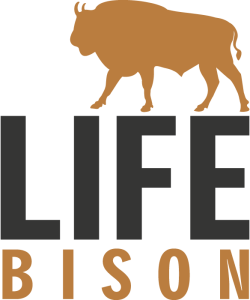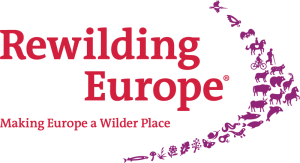The spectacular sight of Europe’s largest land animal running wild is set to become more common in Romania’s Țarcu Mountains. After a long journey from the Avesta Reserve in Sweden, a group of nine European bison arrived at Rewilding Europe’s Southern Carpathians rewilding area on April 22 and 23. The group will eventually join free-roaming animals that have been released here over successive years since 2014.

Trouble-free transfer
Having been hunted to extinction in Romania around 200 years ago, the European bison made a wild return to the country in 2012 (in the Vanatori Neamt Nature Park). Since 2013, Rewilding Europe and WWF Romania have been working together in the Southern Carpathians rewilding area to restablish a free-roaming, viable population of this iconic animal. The first two bison releases took place in 2014 and 2015. In June 2016, a third bison release took place as part of the European Commission-funded LIFE Bison Project – this fourth release represents a continuation of the project’s efforts.
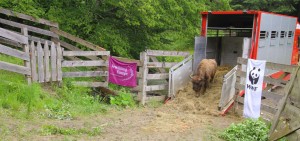
The group of nine bison, originating from Avesta Reserve in Sweden, comprises seven females and two males, ranging in age from two to six years old. The animals were carefully selected based on their genetic make-up, age and gender, to give them the best chance of adapting to and thriving in their new Țarcu Mountains environment. Before they are allowed to roam free, the bison will undergo a two-month acclimatisation period, living in successively larger enclosures before they are finally released into the wild.
“The relocation of bison from Avesta to the Țarcu Mountains has been very successful for numerous reasons,” says Adrian Hagatis, LIFE Bison Project Manager and Team leader of Southern Carpathians rewilding team. “The bison are from the same herd, with an optimum age structure and genetic condition. This reduces the stress on the animals as they adapt to their new environment.”
Hagatis was also impressed with the professional handling of the bison by employees at the Avesta Reserve, and the support of the community of Armenis, located close to the bison release site in Romania.
“The bison loading in Sweden was carried out perfectly,” says Hagatis. “And we are also deeply grateful to the people of Armenis, who have offered their unwavering support to create favourable conditions for the arrival of the new group.”
A tale of two sites
Rewilding Europe and WWF Romania began collaborating on the the bison reintroduction programme in the Țarcu Mountains in late 2012, with the first bison translocation in May 2014. Every year since then, in spring or beginning of summer, new translocations have been organised. Bison have been sourced from zoos, breeding centres and nature reserves across Europe, based in countries such as Belgium, Germany, Italy and Sweden. Thanks to the collaboration, a second group of wild Romanian bison has now been created, after the group in the Vanatori Neamt Nature Park, in the north of Romania. At the moment, around 50 bison now roam free in Romania, across the two reintroduction sites.
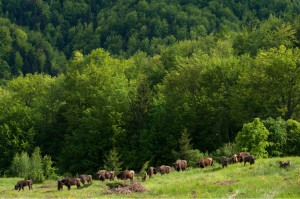
The major objective for the Southern Carpathian bison group is to grow it into a demographically and genetically viable population, with two sub-populations living in Țarcu (already hosting bison) and the nearby Poiana Rusca Mountains (where bison will be reintroduced soon). The LIFE Bison Project will see Rewilding Europe and WWF Romania reintroduce at least 100 bison by 2020, under the framework of the EC-funded LIFE Programme.
A holistic approach
Rewilding Europe’s bison initiative is not only about species reintroduction. The animals are the main driving force in a wider vision that will see nature become an engine for regional development and a source of wellbeing for local communities. This is being made possible through efforts in nature based tourism, community development, education, nature research, technological innovation and conservation efforts that benefit both nature and man.
Research and monitoring are a key focus of Southern Carpathian rewilding team. This will enable us to measure the impact of bison on their new habitat and its biodiversity, to better modify conservation actions going forward, and to better understand and mitigate challenges such as human-wildlife conflict. Our bison conservation work is complemented by a multi-disciplinary research project coordinated from a field research station in the village of Fenes, close to Armenis. A growing body of students, researchers and conservation practitioners are now carrying out research here, based in a former cultural centre.
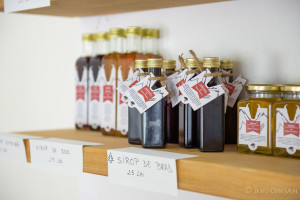
To support local development the bison initiative has encouraged the creation of a local association called AMZA (Bison Hillock Association Armenis). This association acts as the local partner in organising bison transports and releases, building relations with the local authorities, and developing and providing ecotourism services (such as accommodation and meals and bespoke guiding services) and local products. In cooperation with the European Safari Company wildlife experiences such as bison tracking and wildlife watching are now a reality that brings about the development of nature based tourism in the area.
In 2016, a new brand of traditional products and services was created together with AMZA, in order to share local food and handicrafts with the wider public, revitalise the local economy and generate pride. To date the project has led to the creation of four jobs. Two young local Romanians have become bison rangers at the Bison Hillock (in the Țarcu Mountains), while another two have started work at a second bison reintroduction area in the Poiana Rusca Mountains. The role of these rangers is pivotal: they patrol the rewilding area and monitor the movement of bison and other wildlife species, assist with bison releases, and guide visitors through the area.

